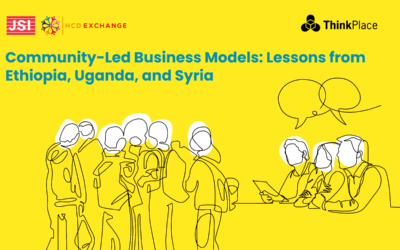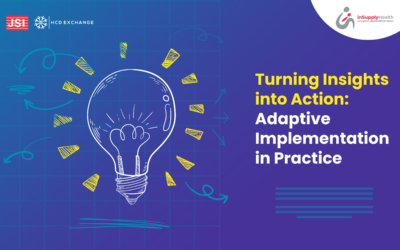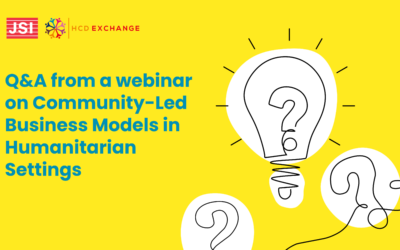The HCDExchange facilitated a workshop at the CORE Group Conference 2024, focusing on the intersection of climate and health. The session aimed to inspire strategic thinking and encourage collaboration among public health practitioners exploring the future of public health programs shaped by environmental challenges.

Why did we choose this theme?
The urgency of this discussion and the workshop’s focus on this theme stems from the growing impact of climate change on health and public health systems globally. These effects intensify as climate-related disasters drive humanitarian crises and population displacement, straining individual health and health systems. Climate shifts are also reducing food’s nutritional value, exacerbating undernutrition levels. Furthermore, extreme weather conditions heighten the spread of diseases and increase other health-related risks. An estimated 3.6 billion people currently live in areas highly vulnerable to climate change, and research from the World Health Organization indicates that between 2030 and 2050, climate change could cause approximately 250,000 additional deaths each year due to undernutrition, malaria, diarrhea, and heat stress alone. This stark reality underscores the need for urgent action. Preventing, preparing for, and building more resilient communities is vital. Integrating climate adaptation strategies into public health programs to mitigate emerging risks and safeguard future health outcomes is equally critical.
We used HCD workshop methods with speculative design principles to explore the theme above. We recognize that while the impacts of climate change are already visible today, its future consequences require foresight and imaginative thinking. Speculative design is beneficial for this purpose, as it helps participants envision potential future scenarios before designing for the present. To encourage this future-oriented perspective, we began our workshop with a speculative design tool that prompted participants to think 10 years ahead. Once grounded in this future outlook, we introduced two HCD methods to guide them in developing human-centered strategies that address present-day challenges.
The workshop flow and tools used
We applied two speculative design tools, Signals and The Future Wheel, facilitating future-focused thinking about climate change’s health impacts. These tools encouraged participants to explore emerging trends and their potential ripple effects, fostering deeper insight into future challenges and opportunities.
A signal in speculative design is a subtle indicator of a new or unfamiliar change in society, technology, or culture. Designers look for signals in the present to imagine alternative futures.
We provided participants with signals representing current challenges across various public health issues resulting from the impact of climate change. These signals served as both a starting point and an anchor, helping participants frame their thinking as they embarked on their ideation journey.
A futures wheel in speculative design is a visual tool that helps people understand the potential consequences of a change, event, or decision.
Anchored in the signals, participants used the Futures Wheel to map both the direct and indirect consequences of their selected signals on people and health systems within communities. This tool facilitated a deeper exploration of how specific signals might unfold. By considering these potential impacts, participants were better equipped during the solution-seeking stage to brainstorm strategies that address both present challenges and future risks. This approach enabled them to design solutions that could be implemented immediately while also laying the groundwork for future preparedness and risk mitigation.
After unpacking and envisioning the potential consequences of their signals, participants shifted toward a more solution-oriented approach. To guide this stage of the workshop, we applied two HCD methods. The first was crafting a How Might We question, which helped frame the problem as an opportunity for innovation and encouraged creative, actionable thinking.
A How Might We question in HCD helps people understand design problems by translating them into actionable questions. It ensures the right problems are addressed while leaving enough room for innovative thinking. At the same time, it provides enough focus so that everyone involved understands the design challenge and knows how to proceed.
This approach helped narrow participants’ thinking, guiding them toward a more focused and systematic ideation process. The How Might We question enabled them to define the specific action or objective they aimed to address, identify the target group they intended to support and envision what success or desired outcomes would look like.
After crafting their How Might We questions, participants used them as anchors to brainstorm potential solutions or strategies. To support this process, we introduced a brainstorming template called the Strategy Board, explicitly designed for the workshop. This tool helped participants organize their ideas systematically and align their proposed strategies with the core challenges identified.
A Brainstorming template is a blank canvas that may sometimes have guiding prompts or questions to help participants in a group navigate a discussion and develop an idea.
Conclusion
Integrating speculative design with HCD methods proved valuable in exploring the intersection of climate and health. This approach encouraged foresight thinking, enabling participants to anticipate potential risks and design adaptive strategies that can be embedded within health interventions. As climate change continues to impact public health, combining speculative design with HCD provides a unique opportunity to create resilient, future-ready solutions.
We invite you to share your experiences using design tools and methods that address the climate and health intersection. Join the conversation on our social media channels or engage with us through our X-change platform—we look forward to learning from your insights!
Reading List
If you’re interested in collaborating with us on a thought piece about this topic, feel free to reach out at community@hcdexchange.org
Summary compiled by Rimjhim Surana, Sr HCD Designer, HCDExchange



